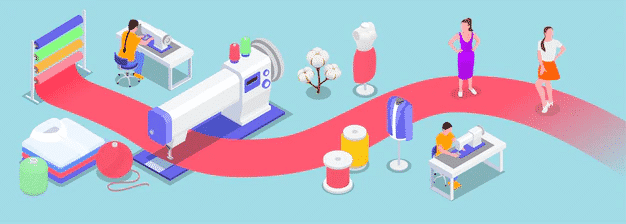Clothing Manufacturing Process: Basic Problems In Clothing Manufacturing Process In 2024
Are you aware of the basic problems in the clothing manufacturing process? In the clothing manufacturing process, there are a few basic problems that new entrepreneurs often face. First, let’s know about garment production before jumping into the problems in the clothing manufacturing process. Garment production is a well-organized process that includes steps like laying, marking, cutting, sewing, inspecting, finishing, pressing, and packing. This is the transformation of raw materials into final goods. It will be difficult to keep the industry going if manufacturing isn’t up to standard and material preparation has not been done properly during the testing and development phase. Communication Issues Designers and manufacturers need to communicate clearly in order to avoid misunderstandings and delays in production. This includes sharing Tech Pack changes, overlooking important details in the dialogue thread, and dealing with the language barrier. Sharing Tech Pack Changes In the first place, a strong Tech Pack is a must. A strong Tech Pack includes: A strong Tech Pack means that the manufacturer doesn’t have to guess what to do. It is very common that changes we made to the Tech Pack during the manufacturing process. There should be a report to the manufacturer regarding any changes, even if they are minor, as this may cause errors or delays. These changes may include, but are not limited to: Documenting changes clearly can prevent 69% of the delays and quality issues. Language When manufacturing in another country, language can be a problem. To translate a Tech Pack, a designer or maker had to browse many programs before proceeding. The Tech Pack have translated into a native language over the course of many hours, if not days. Production Delays The planning and controlling of the clothing manufacturing process are two crucial parts. Planning and controlling the clothing manufacturing process are crucial aspects. On-time shipments of the necessary supplies and prompt delivery to the production are the effect of meticulous planning. Production planning is a complicated process that must have planned out months, if not then even years, in advance. In manufacturing, production timelines are a powerful tool to keep all processes in order. Using them you can keep track of the progress of every project and make any necessary adjustments as needed. To avoid delays, some businesses hire a third-party inspector to oversee the manufacturing. An unbiased inspector visits the factory with your specifications and requirements in hand to ensure that the product fulfills your expectations. Your inspector can inform you where each product is in the manufacturing process, such as which pieces we finished and packaged. They can also offer expert advice on which processes are taking longer than normal and why. Defects During Production Wasted raw materials, extra labor for sorting and resolving issues, and unexpected extra time are all consequences of manufacturing failures. All of this results in additional expenses and financial loss. Let’s simply say that even if both parties did their best, mistakes can occur. However, there is a technique to keep production flaws to a minimum and deal with them rapidly when they do occur. Our primary methods for reducing production flaws are as follows: Product Designing As we already said, a well-crafted Tech Pack is the way to go. The same may be said about product design. Product problems are frequently the result of bad design. As a result, it’s critical to test the sample garment before producing a full series. From the very beginning of the product development process, it is beneficial to include a manufacturing engineer. Their experience enables them to identify potential problems during the early stages of product development. The company can make a great deal of money by doing this. Flexibility During the Production Process Being flexible is one approach to cutting down on the number of production errors. Buying the lining from a local factory mill and obtaining the main fabric from abroad, for example. Changing the path can often have a solution even if the design, materials, and technical aspects we approved. If the required fabric is unavailable, or if the first garment sample fails to meet expectations, the project will be abandoned. We should adopt, accept these adjustments, and focus on finding solutions. Despite the fact that it may mean missing the deadline in addition to devoting additional resources to product development. Smart Manufacturing Using the latest technologies, such as computer modeling and simulation, has proven to be very effective. As a result, We can identify defects and fixed during the early stages of product development. Using tools like Marvelous Designer or Clo3D, you can simulate clothing on a model and see how it fits. Safety Measures for prevention purposes A factory’s preventative measures include ensuring that all operating machinery is in perfect working order. For the designer, it means making sure the factory meets high manufacturing standards. You can learn that by visiting the factory, communicating with the manufacturer, and seeing the samples in person. Make sure to check even the smallest things like the quality of finishing, because they usually define how the particular factory is committed to producing better quality products. Quality Control The most important parts of garment quality control are accurate measurements and sizes. Because the most important factor for most customers is the fit and comfort of a piece of clothing. Set a margin for each point of measurement while submitting your clothing specifications to the manufacturer. Setting a tiny margin of error ensures that the garments we manufactured and tested are in accordance with your specifications. Quality control teams are in place in some businesses. They are in charge of ensuring that the production respects the rules at all times. On-site testing will have performed by the inspector to ensure the garment’s durability and functioning. These exams are extremely comparable to what people do on a daily basis. Alright, so these are pretty much all the basic problems that you may have to suffer while going through the clothing manufacturing process. You might be scared of
Clothing Manufacturing Process: Basic Problems In Clothing Manufacturing Process In 2024 Read More »





